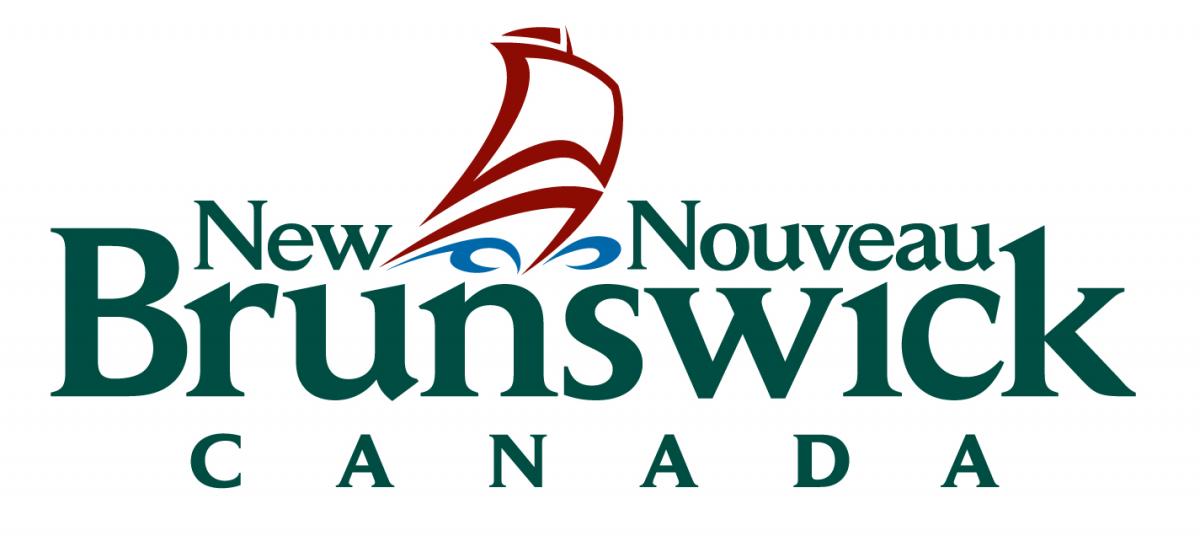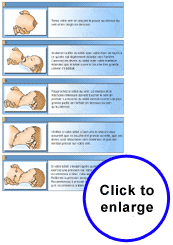MODULE 4
Choosing to Breastfeed
g. Signs that the Baby Is Breastfeeding Well
New mothers often wonder if their baby is drinking enough milk. Although you cannot check the quantity of milk the baby is drinking, there are signs that indicate if the baby is drinking enough.
d. Learning to Breastfeed
Begin breastfeeding as soon as possible after the delivery. The baby is most awake and ready to learn how to breastfeed during the first two hours after birth. Breastfeeding as soon as possible after delivery will favour skin to skin contact with your baby and will help you produce more milk.
Once you are in a comfortable position, you are ready to offer your breast to your baby. The cross cradle position may be the best position for the learning period.
Babies often suck better if their skin is in contact with the mother's skin. They will keep warm from being skin to skin with you. In the beginning, undress the baby down to just their diaper prior to feeds to help keep baby awake at the breast. Some infants find the breast and latch on correctly from the first tries. Others need help. The following pictures provide a few tips to help your baby accept the breast correctly.
The following video shows a baby well positioned on the breast.
Feed the baby before he or she gets upset or cries loudly. Crying is a late sign of hunger. The baby will show signs of hunger long before starting to cry.
Your baby can
- have rapid eye movements under the eyelids when he/she begins waking up to drink.
- make sucking and licking movements with his/her mouth.
- put his/her hand in his/her mouth.
- stretch and become more agitated.
- make small noises.

A sign that the baby is hungry.
Test Your Knowledge
|
|
The following exercise will help you acquire knowledge to make breastfeeding successful.
Click on the button that corresponds to the correct answer and check your answer by clicking on the "Check" button.
|
1 |
It is important to begin breastfeeding as soon as possible after the birth of your baby. |
|
2 |
You must breastfeed every four hours the first few days. |
|
3 |
Do not give a pacifier or bottle to a breastfed baby. |
|
4 |
Most mothers need help to learn how to breastfeed. |
|
5 |
You must always give water to breastfed babies. |
f. Infant Feeding Cues:
Babies should be fed when they cue or indicate hunger. Crying is a late cue or indicator of hunger. Breastfeeding is much easier for both mother and baby if you are able to pick up on baby's early hunger cues.
Sample video from "Breastfeeding : Bringing baby to the breast" from http://www.videoallaitement.org/english.html
Common infant hunger cues include:
Early:
- Increased alertness, moving during sleep or having REM sleep
- Smacking or licking lips
- Opening and closing mouth
- Sucking on lips, tongue, hands, fingers, toes, toys, or clothing.
Active:
- Rooting around on the chest of whoever is carrying him
- Trying to position for nursing, either by lying back or pulling on your clothes
- Fidgeting or squirming around a lot
- Hitting you on the arm or chest repeatedly
- Fussing or breathing fast
Late:
- Moving head frantically from side to side
- Crying
e. Skin-to-Skin Contact
Skin-to-skin contact involves placing the baby wearing only a diaper, tummy down on his/her mother's bare chest immediately after birth and well into the firts month. Baby may be covered lightly with a blanket. Your partner or support person can also do skin-to-skin to know, comfort and nurture your baby.
Benefits:
- Strengthens the mother-baby relationship;
- Helps regulate the baby's body temperature, respirations and heart rate;
- Promotes better breastfeeding;
- Helps regulate the baby's blood sugar;
- Provides pain relief to baby during painful procedures;
- Encourages longer duration of breastfeeding, on average by an additional six weeks.
- The benefits of skin-to-skin for bonding, soothing and breastfeeding continue well after the newborn period.
- Premature babies also benefit from skin-to-skin. Sometimes this is called Kangaroo Care.
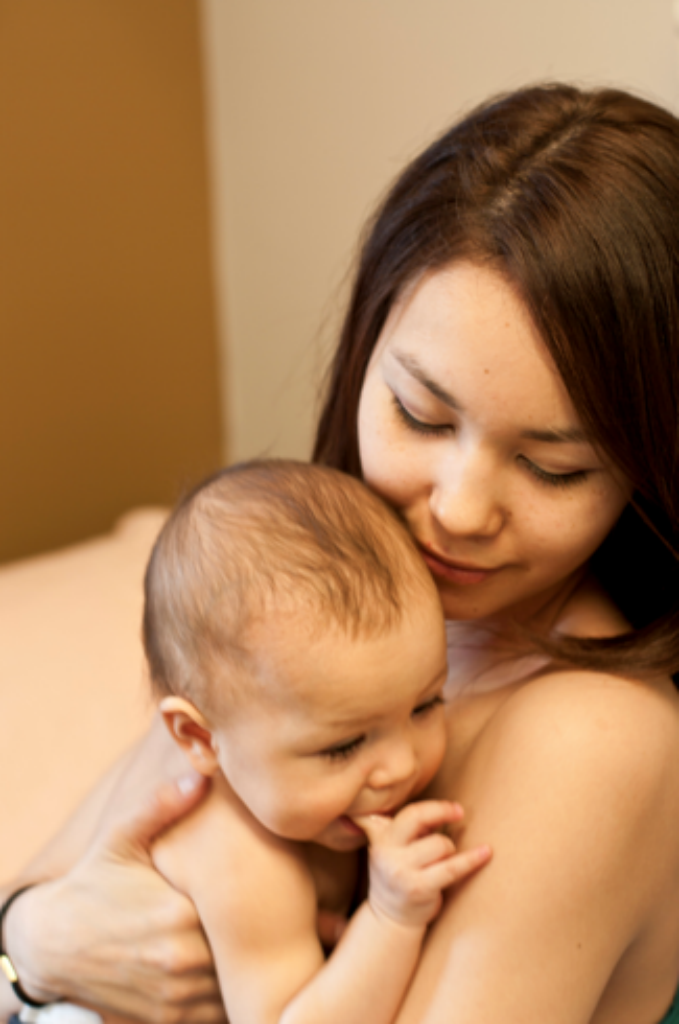
b. The Breast and How It Works
You will notice a big change in your breasts when the baby is born. Once the placenta leaves the body, hormones stimulate the alveoli to produce milk. The milk passes through the lactiferous ducts and is stored in the small reservoirs situated under the areola causing the breasts to swell. You may feel that your breasts are full or even a little tight. If you breastfeed often, these sensations tend to go away.
When the baby is positioned correctly, movements of the mouth squeeze the reservoirs located just under the areola. The milk flows through several small openings located on the tip of the nipple. The position of the baby's mouth on the breast is very important to assure that the baby is breastfeeding well.
The following animation illustrates the production of milk.
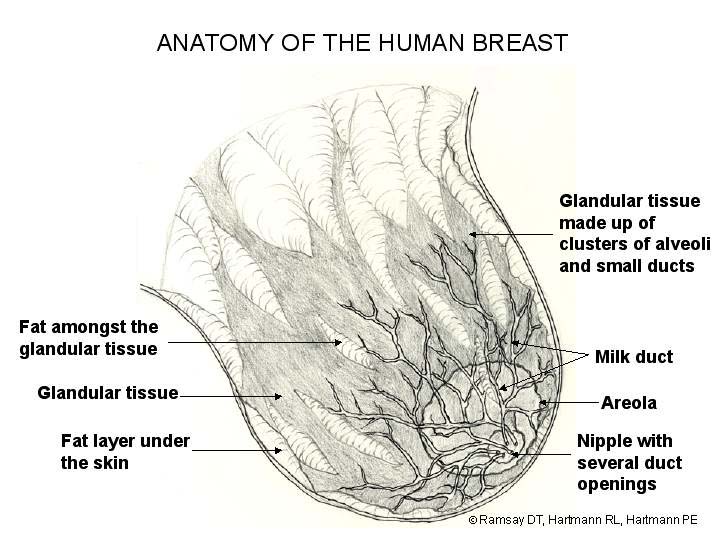
c. Breastfeeding Positions
There are several breastfeeding positions. Follow these suggestions for each position.
- Your back and arms must be well supported. A pillow behind your back and under your arms will help.
- The baby's body and head are raised up to your breast. Place a pillow under the baby.
- The baby's chest must face and touch your chest. Place the baby on his/her side except for the football position.
- For the football position, place the baby on his\her back or slightly turned towards the breast.
- Your baby's nose must face the nipple. Bring the baby towards you instead of leaning forward or pushing your nipple into the baby's mouth.
Remember that it is important to change breastfeeding positions and to offer both breasts at every feeding.
The following pictures illustrate the main breastfeeding positions.
|
Alternate Arm Cradle Hold This position works well, if you are learning to breastfeed:
|
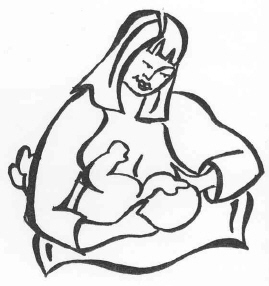 |
|
Football Hold This position works well:
|
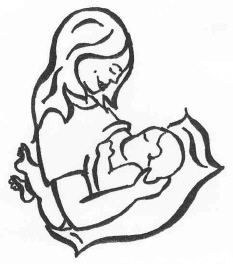 |
|
Cradle Hold This position works well:
|
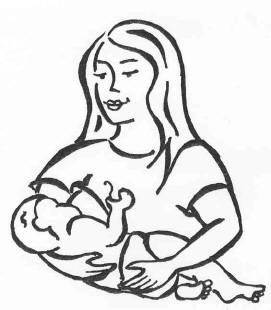 |
|
Side-Lying Hold This position works well:
|
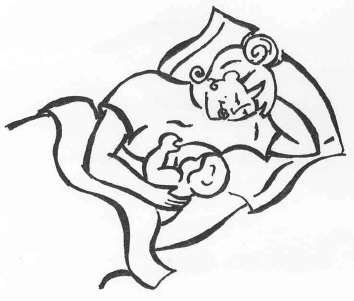 |
B. PREPARING TO BREASTFEED
Once you decide to breastfeed, you can begin to prepare yourself. The time to do this is now while you are pregnant. Successful breastfeeding depends mostly on the confidence you have in your ability to breastfeed. An appropriate preparation is essential in order to develop this confidence. Receiving adequate support, even during pregnancy, will help your confidence when breastfeeding.

a. Changes Occurring in Your Breasts
Your breasts were getting ready to breastfeed even before you thought about being a mother. Milk glands start to grow during the teenage years.
During pregnancy, the breast, areola, and nipple get bigger. The nipple and the areola become darker. The alveoli and the ducts increase in number and grow in size.
Test Your Knowledge
|
|
This exercise will help you verify your knowledge about breastfeeding. You will also find answers to some of your questions.
Click on the button that corresponds to the correct answer and check your answer by clicking on the "Check" button.
|
1 |
Most women are able to breastfeed. |
|
2 |
Mothers with small breasts produce less milk than mothers with big breasts. |
|
3 |
Women with flat or inverted nipples cannot breastfeed. |
|
4 |
Breastfeeding causes the breasts to "sag". |
|
5 |
Breastfeeding takes a lot of time. |
|
6 |
A mother who is breastfeeding must watch what she eats. |
|
7 |
Mothers who smoke can breastfeed their babies. |
|
8 |
A woman who is breastfeeding can become pregnant. |
|
9 |
If a woman breastfeeds, her partner is excluded from providing care to the baby. |
|
10 |
It is possible to continue breastfeeding even after returning to work or to school. |

